Modeling the Evolution of AI Identity Using Structural Features and Temporal Role Dynamics in Complex Networks
Abstract
1. Introduction
Background and Motivation
- How can AI identity be modeled as an emergent phenomenon in dynamic interaction networks?
- What structural and temporal patterns in networks contribute to the formation and coherence of AI identity?
- How can graph-based representations of identity be interpreted and rationalized?
- How well does the proposed network-based identity framework perform on real-world benchmark datasets?
- We propose a graph-based framework that defines AI identity as an emergent property of dynamic, role-driven network interactions.
- We introduce a method for capturing structural and temporal patterns using graph neural networks and motif-based role tracking.
- We develop a rationalization pipeline that interprets identity through graph features such as centrality, entropy, and community evolution.
- We empirically validate our approach using two benchmark datasets—Reddit and AMiner, demonstrating its effectiveness in capturing coherent, interpretable identity trajectories.
2. Related Work
3. Methodology: Network-Based Modeling of Identity
3.1. Identity Construction Framework
| Algorithm 1: Identity Construction and Representation via Temporal Graph Modeling |
| Input: : Raw interaction data (e.g., comments, authorship logs) : Total number of time slices : Motif extraction function : Graph Neural Network model (e.g., GCNs, GATs, and GraphSAGE) |
| Output: : Identity embeddings for node vvv at each time : Role trajectory for each node |
| Step 1: Temporal Graph Construction for to :
|
| Step 2: Structural Feature Encoding for each graph :
|
| Step 3: GNN-Based Representation Learning for each graph :
|
| Step 4: Identity Trajectory and Role Inference for each node :
|
| Return: and for all nodes |
3.2. Network Construction from Data
- denote the set of all agents (nodes),
- the set of edges active at time ttt, and
- a snapshot of the interaction graph at time
3.2.1. Node and Edge Semantics
3.2.2. Temporal and Multiplex Modeling
- be the matrix of node features at time , and
- be the adjacency matrix of layer ℓ at time t.
3.3. Representation Learning via GNNs
3.3.1. Identity Embedding Design
- Local structure: derived from the neighborhood , and
- Global patterns: derived from community roles, motif presence, and position in the graph.
3.3.2. GNN Architectures Used
- adds self-loops,
- is the degree matrix of ,
- is the learnable weight matrix for the layer,
- is an activation function (ReLU).
- Mean aggregation:
- Pooling or LSTM-based functions for higher expressiveness.
3.4. Modeling Emergence and Role Dynamics
3.4.1. Community Detection and Identity Modules
3.4.2. Motif Analysis and Role Structures
3.4.3. Temporal Role Transitions
4. Experimental Validation
4.1. Benchmark Datasets
4.2. Experimental Setup and Results
4.2.1. Data Preprocessing Pipeline
4.2.2. Training Configurations
4.3. Evaluation Metrics
4.3.1. Identity Coherence Metrics
4.3.2. Role Detection Accuracy
4.4. Quantitative Evaluation
4.5. Qualitative Analysis of Identity Evolution
4.6. Ablation and Sensitivity Studies
5. Conclusions and Future Work
Author Contributions
Funding
Data Availability Statement
Conflicts of Interest
References
- Borivoje, B. Decoding identity and representation in the age of AI. Megatrend Rev. Megatrend Rev. 2023, 20, 141. [Google Scholar]
- Lynn, C.W.; Bassett, D.S. The physics of brain network structure, function and control. Nat. Rev. Phys. 2019, 1, 318–332. [Google Scholar] [CrossRef]
- De Domenico, M. Multilayer modeling and analysis of human brain networks. Giga Sci. 2017, 6, gix004. [Google Scholar] [CrossRef] [PubMed]
- Hamilton, W.; Ying, Z.; Leskovec, J. Inductive representation learning on large graphs. Adv. Neural Inf. Process. Syst. 2017, 30, 1025–1035. [Google Scholar]
- Jurafsky, D.; Chai, J.; Schluter, N.; Tetreault, J. In Proceedings of the 58th Annual Meeting of the Association for Computational Linguistics. Online, 5–10 July 2020. [Google Scholar]
- Min, C.; Zhao, Y.; Bu, Y.; Ding, Y.; Wagner, C.S. Has China caught up to the US in AI research? An exploration of mimetic isomorphism as a model for late industrializers. arXiv 2023, arXiv:2307.10198. [Google Scholar] [CrossRef]
- Giouroukelis, M.; Papagianni, S.; Tzivellou, N.; Vlahogianni, E.I.; Golias, J.C. Modeling the effects of the governmental responses to COVID-19 on transit demand: The case of Athens, Greece. Case Study. Transp. Policy 2022, 10, 1069–1077. [Google Scholar] [CrossRef] [PubMed]
- Smaldino, P.; Pickett, C.; Sherman, J.; Schank, J. An agent-based model of social identity dynamics. J. Artif. Soc. Soc. Simul. 2012, 15, 127–143. [Google Scholar] [CrossRef]
- Miritello, G. Temporal Patterns of Communication in Social Networks; Springer Science & Business Media: Berlin, Germany, 2013. [Google Scholar]
- Ross, S.; Munoz, D.; Hebert, M.; Bagnell, J.A. Learning message-passing inference machines for structured prediction. In Proceedings of the CVPR 2011, Colorado Springs, CO, USA, 21–23 June 2011; pp. 2737–2744. [Google Scholar]
- Wang, Y.; Chen, S.; Chen, G.; Shurberg, E.; Liu, H.; Hong, P. Motif-based graph representation learning with application to chemical molecules. Informatics 2023, 10, 8. [Google Scholar] [CrossRef]
- Ghosh, A.; Dhebar, Y.; Guha, R.; Deb, K.; Nageshrao, S.; Zhu, L.; Tseng, E.; Filev, D. Interpretable AI agent through nonlinear decision trees for lane change problem. In Proceedings of the 2021 IEEE Symposium Series on Computational Intelligence (SSCI), Orlando, FL, USA, 20 August 2021; pp. 1–8. [Google Scholar]
- Quaranta, G.; Lacarbonara, W.; Masri, S.F. A review on computational intelligence for the identification of nonlinear dynamical systems. Nonlinear Dyn. 2020, 99, 1709–1761. [Google Scholar] [CrossRef]
- Xu, Y. Learning with Conversational Agents; University of California Irvine: Irvine, CA, USA, 2020. [Google Scholar]
- Castelfranchi, C. Modelling social action for AI agents. Artif. Intell. 1998, 103, 157–182. [Google Scholar] [CrossRef]
- Boccaletti, S.; Bianconi, G.; Criado, R.; Del Genio, C.I.; Gómez-Gardenes, J.; Romance, M.; Sendina-Nadal, I.; Wang, Z.; Zanin, M. The structure and dynamics of multilayer networks. Phys. Rep. 2014, 544, 1–122. [Google Scholar] [CrossRef] [PubMed]
- Ucer, S.; Ozyer, T.; Alhajj, R. Explainable artificial intelligence through graph theory by generalized social network analysis-based classifier. Sci. Rep. 2022, 12, 15210. [Google Scholar] [CrossRef] [PubMed]
- Mitra, A.; Paul, S. Analyzing social networks with dynamic graphs: Unravelling the ever-evolving connections. In Applied Graph Data Science; Elsevier: Amsterdam, The Netherlands, 2025; pp. 195–214. [Google Scholar]
- Xu, Y.; Wang, L.; Wang, Y.; Fu, Y. Adaptive trajectory prediction via transferable GNN. In Proceedings of the IEEE/CVF Conference on Computer Vision and Pattern Recognition, New Orleans, LA, USA, 19–24 June 2022; pp. 6520–6531. [Google Scholar]
- Jiang, S.; Huang, Z.; Luo, X.; Sun, Y. CF-GODE: Continuous-time causal inference for multi-agent dynamical systems. In Proceedings of the 29th ACM SIGKDD Conference on Knowledge Discovery and Data Mining, Long Beach, CA, USA, 6–10 August 2023; pp. 997–1009. [Google Scholar]
- Sankar, A.; Wang, J.; Krishnan, A.; Sundaram, H. Self-supervised role learning for graph neural networks. Knowl. Inf. Syst. 2022, 64, 2091–2121. [Google Scholar] [CrossRef]
- Deng, L.; Zhao, Y.; Chen, J.; Liu, S.; Xia, Y.; Zheng, K. Learning to hash for trajectory similarity computation and search. In Proceedings of the 2024 IEEE 40th International Conference on Data Engineering (ICDE), Utrecht, The Netherlands, 13–16 May 2024; pp. 4491–4503. [Google Scholar]
- Polat, C.; Tuncel, M.; Kurban, M.; Serpedin, E.; Kurban, H. xchemagents: Agentic AI for explainable quantum chemistry. arXiv 2025, arXiv:2505.20574. [Google Scholar]
- Custode, L.L.; Iacca, G. Social interpretable reinforcement learning. In Proceedings of the International Conference on the Applications of Evolutionary Computation (Part of EvoStar), Trieste, Italy, 23–25 April 2025; pp. 3–19. [Google Scholar]
- Kazemi, S.M.; Goel, R.; Jain, K.; Kobyzev, I.; Sethi, A.; Forsyth, P.; Poupart, P. Representation learning for dynamic graphs: A survey. J. Mach. Learn. Res. 2020, 21, 2648–2720. [Google Scholar]
- Kaggle. The Reddit Dataset; Kaggle: San Francisco, CA, USA, 2022. [Google Scholar]
- Mader, K.S. AMiner Academic Citation Dataset; Kaggle: San Francisco, CA, USA, 2018. [Google Scholar]
- Fu, D.; He, J. GitHub Interaction Network Dataset, GitHub. 2022. Available online: https://github.com/DongqiFu/DPPIN (accessed on 23 March 2025).
- Zhao, L.; Song, Y.; Zhang, C.; Liu, Y.; Wang, P.; Lin, T.; Deng, M.; Li, H. T-GCN: A temporal graph convolutional network for traffic prediction. IEEE Trans. Intell. Transp. Syst. 2019, 21, 3848–3858. [Google Scholar] [CrossRef]
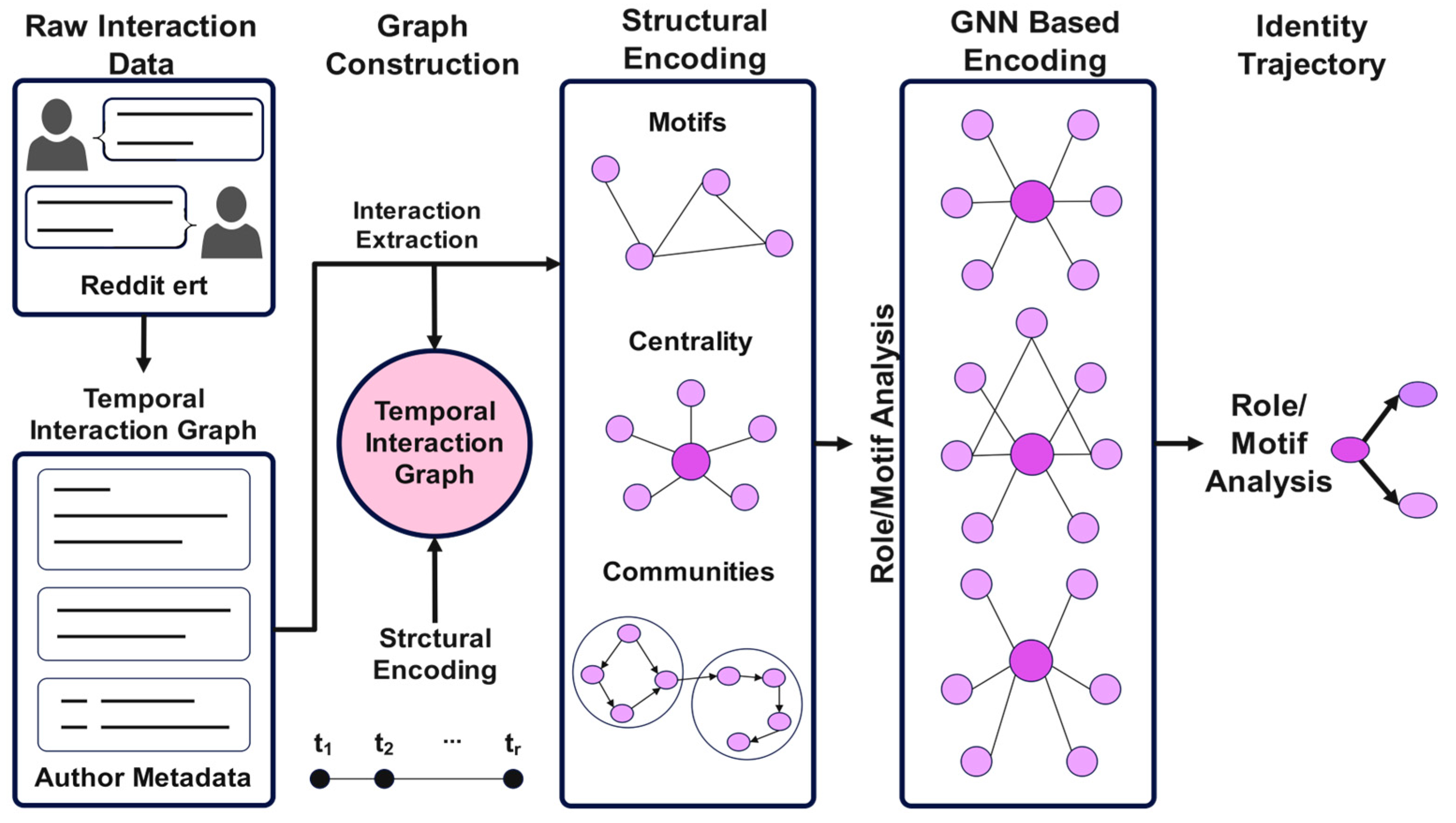
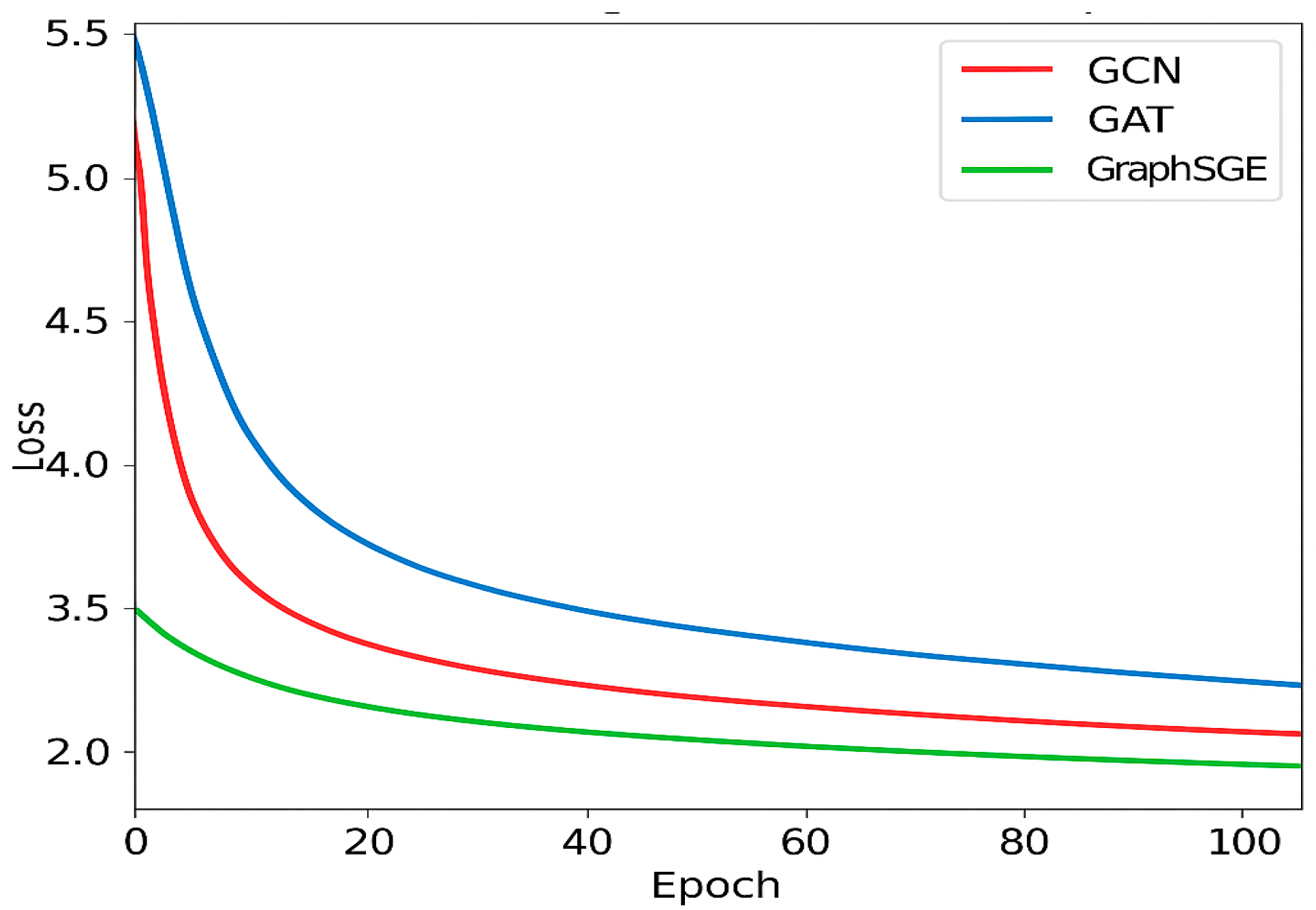
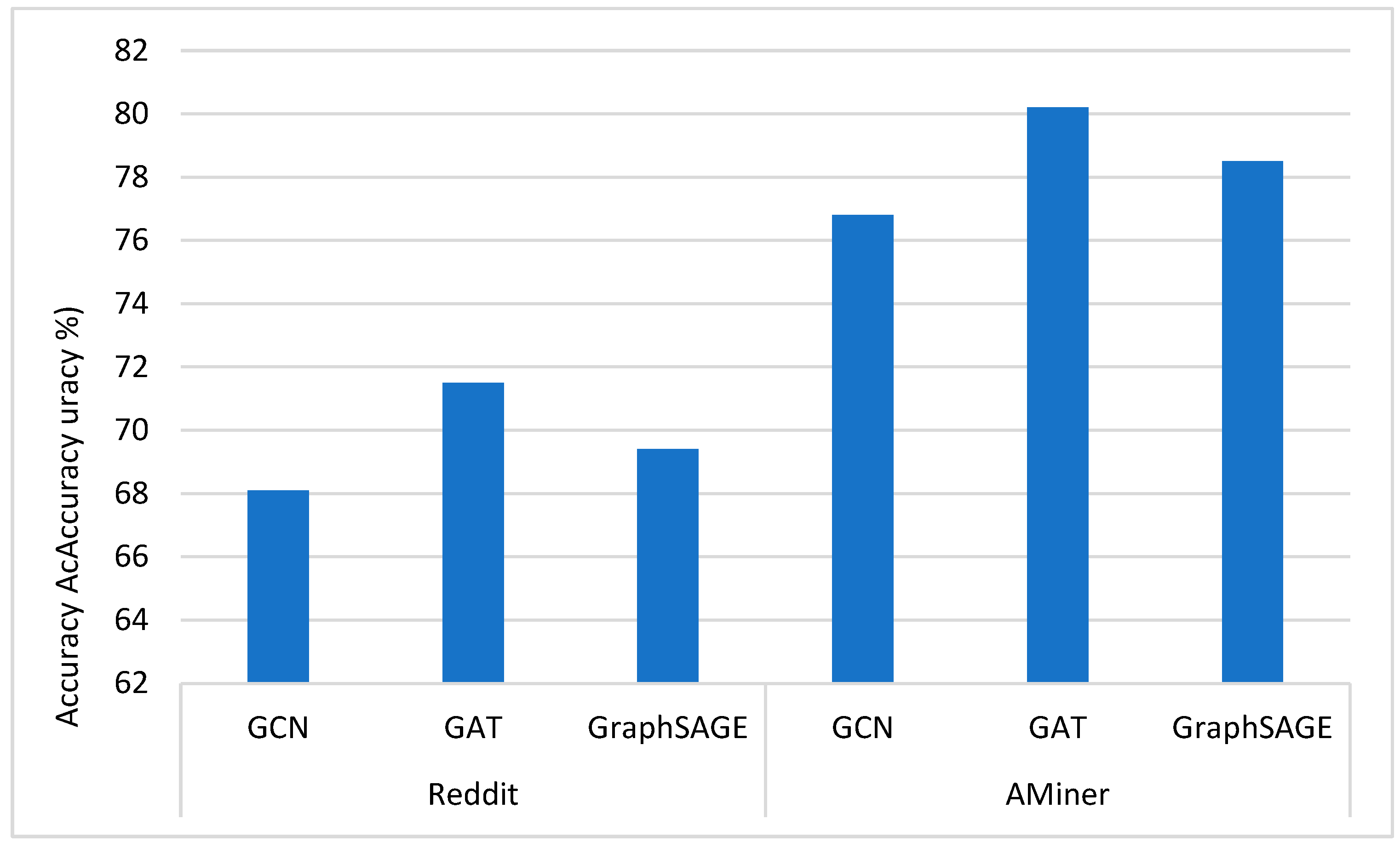
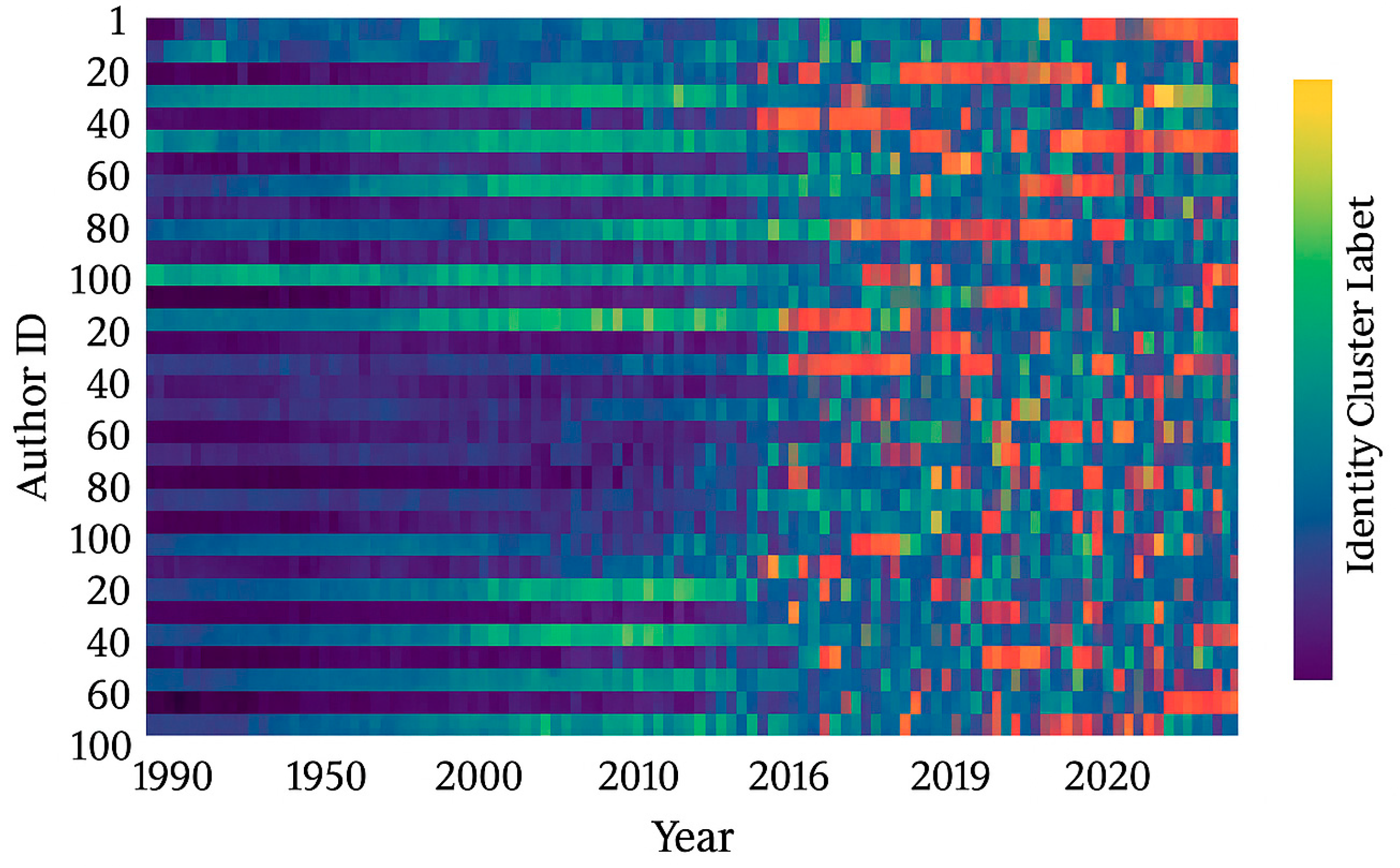


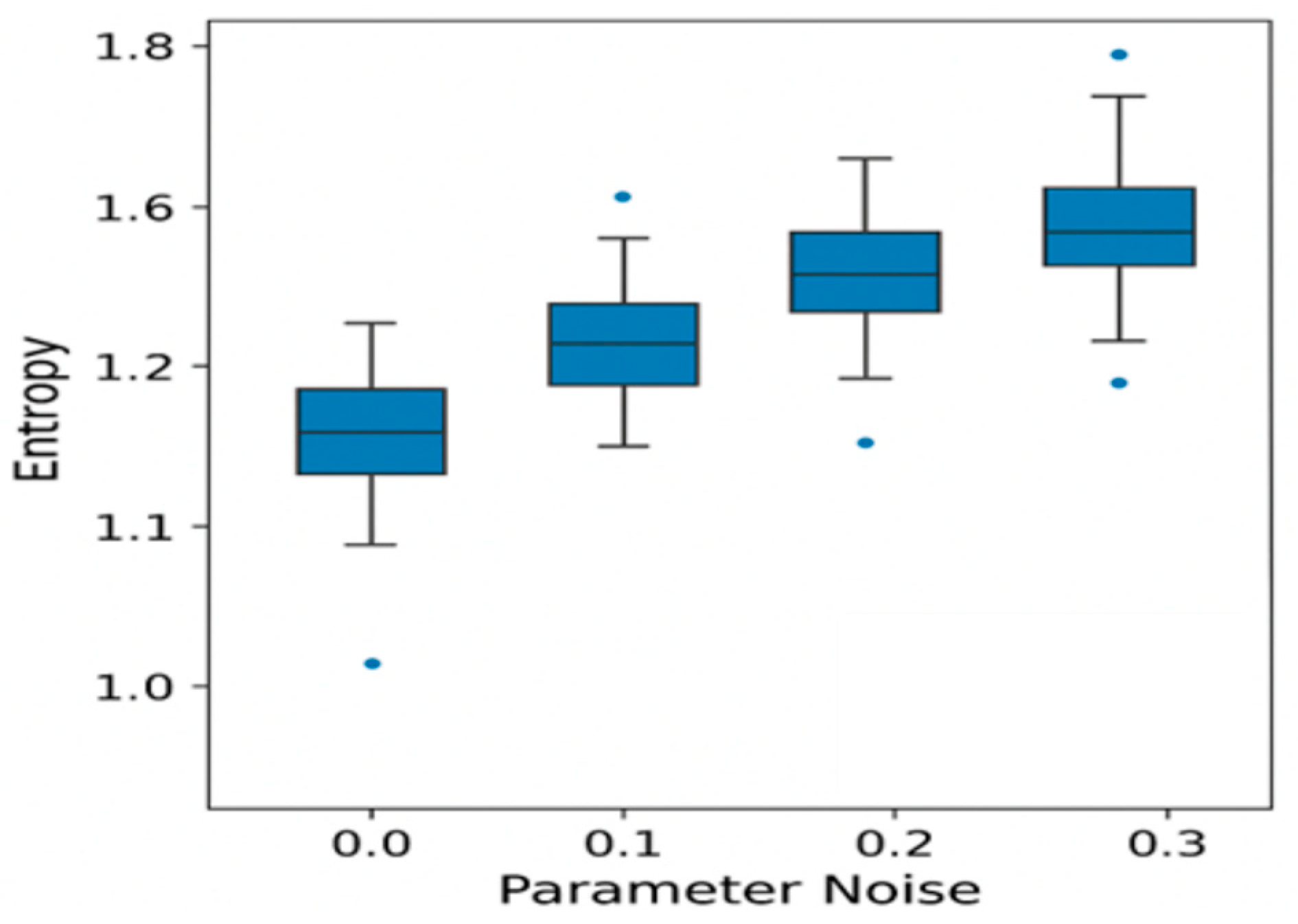
| Property | Reddit Interaction Network | AMiner Co-Authorship Network | GitHub Interaction Network |
|---|---|---|---|
| Domain | Social media discussions | Academic collaboration | Software development and collaboration |
| Time Range | 6 months, 2022 | 30 years, 1990–2020 | 6 months, 2023 |
| Time Granularity | 7 days | 1 year | 14 days |
| Number of Time Slices | 24 | 31 | 24 |
| Number of Nodes (V) | 12,460 | 21,780 | 8200 |
| Number of Edges (E) | 1,634,200 | 2,957,842 | 67,000 |
| Average Degree | 13.1 | 9.3 | 8.1 |
| Node Attributes | Activity metrics, subreddit ID | Paper count, field diversity | Repository participation, contribution count |
| Edge Attributes | Reply frequency, thread depth | Publication type, venue tier | Pull requests, issue comments, and co-commit frequency |
| Interaction Types | Replies, mentions | Co-authorships | Code reviews, issue discussions, and collaborations |
| Graph Type | Temporal directed multigraph | Temporal undirected graph | Temporal directed multigraph |
| Avg. Motif Participation Rate | High, triadic interactions | Medium, cliques, and star structures | Moderate, collaboration loops and review triads |
| Dataset | Model | Avg. Coherence | Std. Dev. | Max | Min |
|---|---|---|---|---|---|
| GCN | 0.682 | 0.103 | 0.917 | 0.456 | |
| GAT | 0.714 | 0.097 | 0.935 | 0.488 | |
| GraphSAGE | 0.691 | 0.099 | 0.912 | 0.467 | |
| AMiner | GCN | 0.832 | 0.076 | 0.961 | 0.638 |
| GAT | 0.854 | 0.071 | 0.973 | 0.653 | |
| GraphSAGE | 0.841 | 0.073 | 0.964 | 0.629 | |
| GitHub | GCN | 0.826 | 0.081 | 0.947 | 0.619 |
| GAT | 0.842 | 0.078 | 0.958 | 0.631 | |
| GraphSAGE | 0.833 | 0.080 | 0.951 | 0.624 |
| Dataset | Model | Modularity | Purity | NMI | ARI |
|---|---|---|---|---|---|
| GCN | 0.412 | 0.652 | 0.603 | 0.541 | |
| GAT | 0.468 | 0.681 | 0.637 | 0.572 | |
| GraphSAGE | 0.435 | 0.664 | 0.615 | 0.558 | |
| AMiner | GCN | 0.578 | 0.721 | 0.689 | 0.663 |
| GAT | 0.604 | 0.748 | 0.713 | 0.685 | |
| GraphSAGE | 0.591 | 0.736 | 0.701 | 0.674 | |
| GitHub | GCN | 0.563 | 0.712 | 0.676 | 0.648 |
| GAT | 0.582 | 0.729 | 0.692 | 0.661 | |
| GraphSAGE | 0.571 | 0.718 | 0.684 | 0.654 |
| Dataset | Model | Accuracy | Macro F1 | Precision | Recall |
|---|---|---|---|---|---|
| Reddi | GCN | 68.1 | 66.2 | 67.5 | 65.1 |
| GAT | 71.5 | 69.6 | 70.9 | 68.3 | |
| GraphSAGE | 69.4 | 67.1 | 68.1 | 66.2 | |
| AMiner | GCN | 76.8 | 74.2 | 75.1 | 73.5 |
| GAT | 80.2 | 77.9 | 78.8 | 77.2 | |
| GraphSAGE | 78.5 | 75.6 | 76.7 | 74.9 |
| Dataset | Model | Avg. Cosine Sim | Std. Dev. | Max | Min |
|---|---|---|---|---|---|
| GCN | 0.619 | 0.114 | 0.902 | 0.391 | |
| GAT | 0.642 | 0.108 | 0.921 | 0.418 | |
| GraphSAGE | 0.634 | 0.111 | 0.913 | 0.405 | |
| AMiner | GCN | 0.791 | 0.084 | 0.950 | 0.588 |
| GAT | 0.814 | 0.078 | 0.963 | 0.612 | |
| GraphSAGE | 0.802 | 0.081 | 0.957 | 0.601 |
| Configuration | Identity Coherence | Role Accuracy (%) | NMI | Avg. Variance |
|---|---|---|---|---|
| Full Model | 0.854 | 80.2 | 0.713 | 0.072 |
| w/o Temporal Layer | 0.789 | 75.6 | 0.654 | 0.105 |
| w/o Motif Layer | 0.801 | 77.1 | 0.667 | 0.089 |
| w/o Both (Baseline GCNs only) | 0.742 | 72.8 | 0.611 | 0.118 |
| Dataset | Model | Dropout (%) | Avg. Variance | Std. Dev. |
|---|---|---|---|---|
| GCN | 10 | 0.091 | 0.015 | |
| 30 | 0.138 | 0.024 | ||
| GAT | 10 | 0.072 | 0.013 | |
| 30 | 0.106 | 0.019 | ||
| AMiner | GCN | 10 | 0.056 | 0.008 |
| GAT | 10 | 0.045 | 0.007 |
| Dataset | Training Strategy | Epochs Per Slice | Total Epochs | Avg. Training Time (Per Epoch) | Total Runtime (h) | Peak GPU Memory (GB) | Temporal Consistency (ΔCoherence) | Storage Usage (GB) |
|---|---|---|---|---|---|---|---|---|
| Independent per-slice training | 50 | 1200 | 38 s | 12.7 | 6.4 | – | 9.8 | |
| Shared-weights + temporal regularization | 50 | 300 | 36 s | 3.1 | 4.2 | +0.007 | 3.4 | |
| AMiner | Independent per-slice training | 80 | 2480 | 54 s | 37.2 | 8.9 | – | 15.6 |
| Shared-weights + temporal regularization | 80 | 620 | 50 s | 9.1 | 6.3 | +0.009 | 6.8 | |
| GitHub | Independent per-slice training | 60 | 1440 | 41 s | 16.4 | 7.2 | – | 11.2 |
| Shared-weights + temporal regularization | 60 | 360 | 39 s | 4.1 | 5.0 | +0.006 | 4.5 |
| Configuration | Modularity | Role Accuracy (%) | Identity Coherence | NMI |
|---|---|---|---|---|
| Full Multiplex | 0.468 | 71.5 | 0.714 | 0.637 |
| No Inter-subreddit Edges | 0.393 | 66.9 | 0.663 | 0.574 |
| Model/Method | Identity Type Modeled | Temporal Modeling | Structural Awareness | Interpretability | Dataset Used | Accuracy/Metric |
|---|---|---|---|---|---|---|
| Rule-Based Agents [13] | Symbolic, fixed roles | ☒ No | ☒ None | ☑ High | Simulated dialogues | N/A |
| User2Vec [15] | Latent vector embeddings | Implicit (via logs) | ☒ None | ☒ Low | E-commerce, forums | Hit@10: 34.5% |
| DeepWalk/Node2Vec [21] | Structural identity (static) | ☒ No | ☑ Local neighborhoods | Medium | Citation networks | Role Clustering F1: 62% |
| Role2Vec [22] | Structural roles (static) | ☒ No | ☑ Motif-aware | ☑Moderate | Social networks | Modularity: 0.38 |
| Temporal GCN (T-GCN) [29] | Temporal embeddings | ☑ Yes | ☑ Moderate | Low | Traffic, social data | MAE ↓: 2.31 |
| DySAT [25] | Dynamic graph embeddings | ☑ Yes | ☑ Structural + Temporal | Medium | Social & co-author data | Accuracy: 77.1% |
| Proposed Model (GNN+Motif+Temporal) | Emergent identity roles | ☑ Full | ☑ High (motifs, communities) | ☑ Moderate–High | Reddit, AMiner | Role Accuracy: 80.2%, Coherence: 0.854 |
Disclaimer/Publisher’s Note: The statements, opinions and data contained in all publications are solely those of the individual author(s) and contributor(s) and not of MDPI and/or the editor(s). MDPI and/or the editor(s) disclaim responsibility for any injury to people or property resulting from any ideas, methods, instructions or products referred to in the content. |
© 2025 by the authors. Licensee MDPI, Basel, Switzerland. This article is an open access article distributed under the terms and conditions of the Creative Commons Attribution (CC BY) license (https://creativecommons.org/licenses/by/4.0/).
Share and Cite
Lu, Y.; Mydin, R.M.; Vengadasamy, R. Modeling the Evolution of AI Identity Using Structural Features and Temporal Role Dynamics in Complex Networks. Mathematics 2025, 13, 3315. https://doi.org/10.3390/math13203315
Lu Y, Mydin RM, Vengadasamy R. Modeling the Evolution of AI Identity Using Structural Features and Temporal Role Dynamics in Complex Networks. Mathematics. 2025; 13(20):3315. https://doi.org/10.3390/math13203315
Chicago/Turabian StyleLu, Yahui, Raihanah Mhod Mydin, and Ravichandran Vengadasamy. 2025. "Modeling the Evolution of AI Identity Using Structural Features and Temporal Role Dynamics in Complex Networks" Mathematics 13, no. 20: 3315. https://doi.org/10.3390/math13203315
APA StyleLu, Y., Mydin, R. M., & Vengadasamy, R. (2025). Modeling the Evolution of AI Identity Using Structural Features and Temporal Role Dynamics in Complex Networks. Mathematics, 13(20), 3315. https://doi.org/10.3390/math13203315






